Sustainability of the Linkages Between Water–Energy–Food Resources Based on Structural Equation Modeling Under Changing Climate: A Case Study of Narok County (Kenya) and Vhembe District Municipality (South Africa)
Abstract
1. Introduction
2. Materials and Methods
3. Results and Discussion
3.1. Questionnaire Descriptive Statistics
3.2. Questionnaire Distribution Statistics
3.3. Structural Equation Model
4. Conclusions
Author Contributions
Funding
Institutional Review Board Statement
Informed Consent Statement
Data Availability Statement
Acknowledgments
Conflicts of Interest
Appendix A
| Short Name | Full Name | Question from Survey |
| wef_dev | Development | Which illustrates that the community experiences scarcity of water, energy, and food resources due to changes in population and urbanization? |
| Wef_cc | Climate Change | The community/region experiences scarcity of water, energy, and food resources due to changes in climate change hazards. |
| vul | Vulnerability | The community/region is a high-risk area and is vulnerable to extreme weather due to economic and socio-environmental drivers of change. |
| exp | Exposure | The community has high exposure and is sensitive to the limited water, energy, and food resources due to economic and socio-environmental drivers of change. |
| wash | Water, Sanitation, and Hygiene | The community experiences a mortality rate that can be attributed to unsafe water, unsafe sanitation, and lack of hygiene. |
| nutr | Nutrition | The malnutrition prevalent in the community is associated with the food insecurity among the residents. |
| a_water | Access to Water | Available and accessible freshwater resources in the community can meet our needs now and in the future. |
| c_rec | Recovery | Community can recover from economic and socio-environmental disruptions (e.g., famine, floods, high food prices, conflict). |
| p_gov | Government | Weak government institutions impact the wellbeing of the community. |
| crop_irr | Crop Irrigation | Crops produced through irrigation in the community can meet our needs now and in the future. |
| a-elec | Access to Electricity | The electricity accessible to the community is enough to use now and in the future. |
| ac_ecd | Economic Development | Energy produced to support economic growth in the community is enough for our needs now and in the future. |
| s-food | Food Security | Our access to nutritious and affordable food by the community can meet our needs now and in the future. |
References
- Bazilian, M.; Rogner, H.; Howells, M.; Hermann, S.; Arent, D.; Gielen, D.; Steduto, P.; Mueller, A.; Komor, P.; Tol, R.J.; et al. Considering the energy, water and food nexus: Towards an integrated modelling approach. Energy Policy 2011, 39, 7896–7906. [Google Scholar] [CrossRef]
- van Vuuren, D.P.; Nakicenovic, N.; Riahi, K.; Brew-Hammond, A.; Kammen, D.; Modi, V.; Nilsson, M.; Smith, K.R. An energy vision: The transformation towards sustainability—Interconnected challenges and solutions. Curr. Opin. Environ. Sustain. 2012, 4, 18–34. [Google Scholar] [CrossRef]
- Adom, R.K.; Simatele, M.D.; Reid, M. Addressing the challenges of water-energy-food nexus programme in the context of sustainable development and climate change in South Africa. J. Water Clim. Change 2022, 13, 2721. [Google Scholar] [CrossRef]
- Liu, L.; Yang, H.; Cudennec, C.; Gain, A.K.; Hoff, H.; Lawford, R.; Qi, J.; de Strasser, L.; Yillia, P.T.; Zheng, C. Challenges in operationalising the water-energy-food nexus. Hydrol. Sci. J. 2017, 65, 28–42. [Google Scholar]
- Bhaduri, A.; Ringler, C.; Dombrowski, I.; Mohtar, R.; Scheumann, W. Sustainability in the water-energy-food nexus. Water Int. 2015, 40, 723–732. [Google Scholar] [CrossRef]
- Biba, S. The goals and reality of the water-food-energy security nexus: The case of China and its southern neighbours. Third World Q. 2016, 37, 51–70. [Google Scholar] [CrossRef]
- Botai, J.O.; Botai, C.M.; Ncongwane, K.P.; Mpandeli, S.; Nhamo, L.; Masinde, M.; Adeola, A.M.; Mengistu, M.G.; Tazvinga, H.; Murambadoro, M.D.; et al. A Review of theWater–Energy–Food Nexus Research in Africa. Sustainability 2021, 3, 1762. [Google Scholar] [CrossRef]
- Nhamo, N.; Mabhaudhi, T.; Mpandeli, S.; Dickensc, C.; Nhemachenad, C.; Senzanjee, A.; Naidooa, D.; Liphadzia, S.; Modib, A.T. An integrative analytical model for the water-energy-food nexus: South Africa case study. Environ. Sci. Policy 2020, 109, 15–24. [Google Scholar] [CrossRef]
- Rasul, G.; Sharma, B. The nexus approach to water–energy–food security: An option for adaptation to climate change. Clim. Policy 2016, 16, 682–702. [Google Scholar] [CrossRef]
- Zaman, K.; Shamsuddin, S.; Ahmad, M. Energy-water-food nexus under financial constraint environment: Good, the bad, and the ugly sustainability reforms in sub-Saharan African countries. Environ. Sci. Pollut. Res. 2017, 15, 13358–13372. [Google Scholar] [CrossRef]
- Thuo, S.; Schreiner, B.; Byakika, S. The Water-Energy-Food Nexus and Poverty Eradication in Kenya. POLICY BRIEF 2/17; Pegasys Institute: Pretoria, South Africa, 2017. [Google Scholar]
- Korir, J.; Ngenoh, E. Factors Influencing the Adaptation Decisions to Impacts of Climate Change among the Maasai Pastoral Community in Narok County, Kenya. Agric. Sci. 2019, 10, 689–705. [Google Scholar] [CrossRef]
- KWTA. Kenya Water Towers Status Report; Kenya Water Towers Agency: Narok, Kenya, 2015. [Google Scholar]
- KWTA. Strategic Plan 2016–2020; Kenya Water Towers Agency: Narok, Kenya, 2016. [Google Scholar]
- Cho, M.A.; Ramoelo, A.; Sibanda, L.M. Exploring the Integration of the Land, Water, and Energy Nexus in Sustainable Food Systems Research through a Socio-Economic Lens: A Systematic Literature Review. Sustainability 2023, 15, 16528. [Google Scholar] [CrossRef]
- Kom, Z.; Nethengwe, N.S.; Mpandeli, N.S.; Chikoore, H. Determinants of small-scale farmers’ choice and adaptive strategies in response to climatic shocks in Vhembe District, South Africa. GeoJournal 2020, 87, 677–700. [Google Scholar] [CrossRef]
- Nesamvuni, A.E.; Tshikolomo, K.A.; Mpandeli, N.S.; De Bruyn, M.; Hlophe-Ginindza, S.; Van Niekerk, J. Perceptions on irrigation water supply and utilisation by smallholder agricultural enterprises in Vhembe district of Limpopo Province, South Africa. Tech. Soc. Sci. J. 2022, 27, 968–979. [Google Scholar] [CrossRef]
- Oni, S.A.; Maliwichi, L.L.; Obadire, O.S. Socio-Economic Factors Affecting Smallholder Farming and Household Food Security: A Case of Thulamela Local Municipality in Vhembe District of Limpopo Province, South Africa. Afr. J. Agric. Res. 2010, 5, 2289–2296. [Google Scholar]
- Botai, C.M.; Botai, J.O.; Tazvinga, H.; Murambadoro, M.; Nhamo, L.; Ncongwane, K.P.; Mengistu, M.G.; Zwane, N.; Wamiti, E.; Mpandeli, S.; et al. Assessment of rural livelihoods, health and wellbeing in Vhembe District Municipality, South Africa and Narok County, Kenya: A water-energy-food nexus perspective. Environ. Sci. Policy 2024, 159, 103817. [Google Scholar] [CrossRef]
- An, D. Interactions in water-energy-food security nexus: A case study of South Korea. Front. Water 2022, 4, 943053. [Google Scholar] [CrossRef]
- Abulibdeh, A.; Zaidan, E. Managing the water-energy-food nexus on an integrated geographical scale. Environ. Dev. 2020, 33, 100498. [Google Scholar] [CrossRef]
- Meybeck, A.; Laval, E.; Lévesque, R.; Parent, G. Food security and nutrition in the age of climate change. In Proceedings of the International Symposium Organized by the Government of Québec in Collaboration with FAO, Québec City, QC, Canada, 24–27 September 2017; p. 132. [Google Scholar]
- Funk, W.C.; Blouin, M.S.; Corn, P.S.; Maxell, B.A.; Pilliod, D.S.; Amish, S.; Allendorf, F.W. Population structure of Columbia spotted frogs (Rana luteiventris) is strongly affected by the landscape. Mol. Ecol. 2005, 14, 483–496. [Google Scholar] [CrossRef]
- World Meteorological Organization. WMO Global Annual to Decadal Climate Update. 2024. Available online: https://library.wmo.int/idurl/4/68910 (accessed on 16 October 2024).
- Schutte, C.F.; Pretorius, W.A. Water demand and population growth. Water SA 1997, 23, 127–133. Available online: https://www.wrc.org.za/wp-content/uploads/mdocs/WaterSA_1997_02_1006.PDF (accessed on 16 October 2024).
- Cole, M.J.; Bailey, R.M.; Cullis, J.D.; New, M.G. Spatial inequality in water access and use in South Africa. Water Policy 2018, 20, 37–52. [Google Scholar] [CrossRef]
- Munene, L.N.; Maina, E.W.; Singh, B.M.; Vojinovic, Z.; Gersonius, B. Adaptation to the impacts of climate and demographic changes on water supply and demand in Nairobi, Kenya. Water Supply 2024, 24, 3359–3371. [Google Scholar] [CrossRef]
- Mulwa, F.; Li, Z.; Fangninou, F.F. Water scarcity in Kenya: Current status, challenges and future solutions. Open Access Libr. J. 2021, 8, 1–5. [Google Scholar] [CrossRef]
- Engelbrecht, F.; Monteiro, P. Climate Change: The IPCC’s latest assessment report. Quest 2021, 17, 34–35. [Google Scholar]
- Bouwer, L.M. Observed and projected impacts from extreme weather events: Implications for loss and damage. In Loss and Damage from Climate Change. Climate Risk Management, Policy and Governance; Springer: Cham, Switzerland, 2019; pp. 63–82. [Google Scholar]
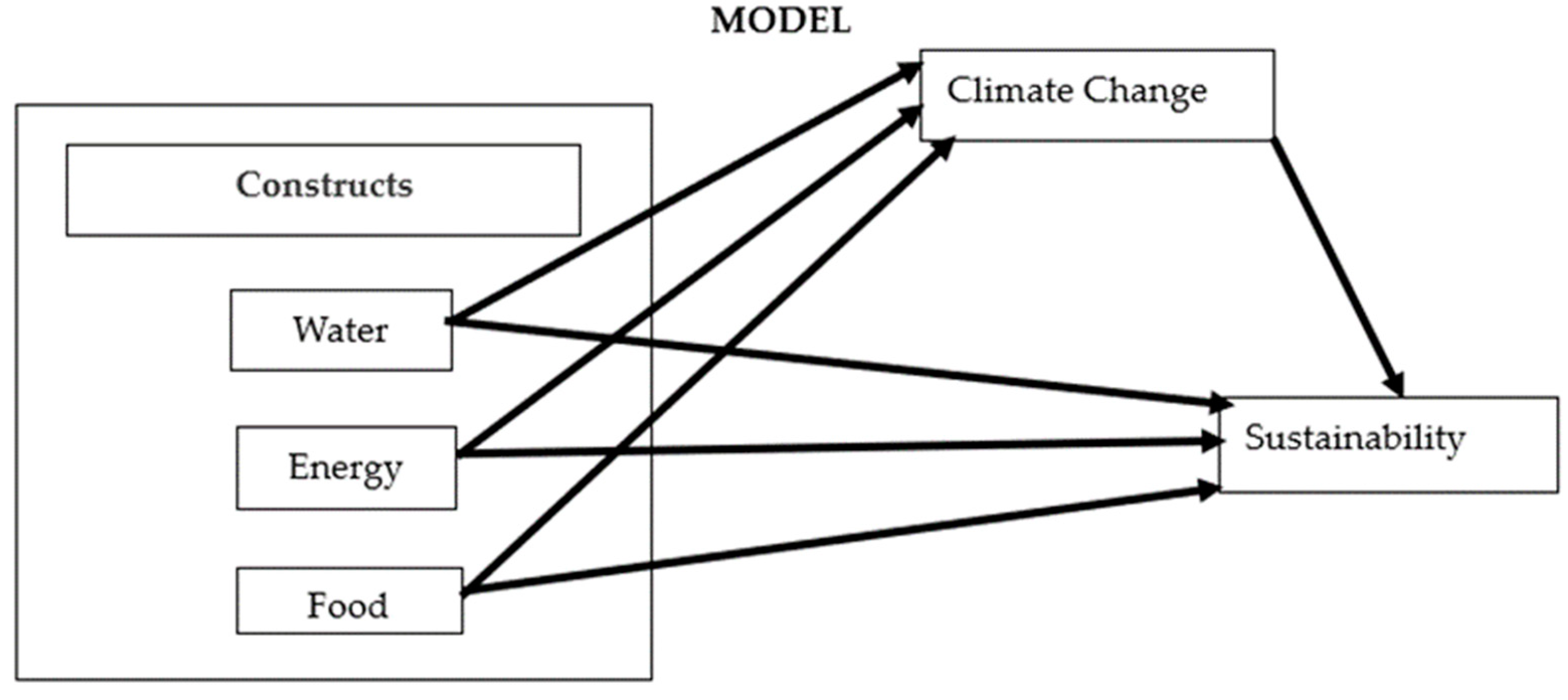



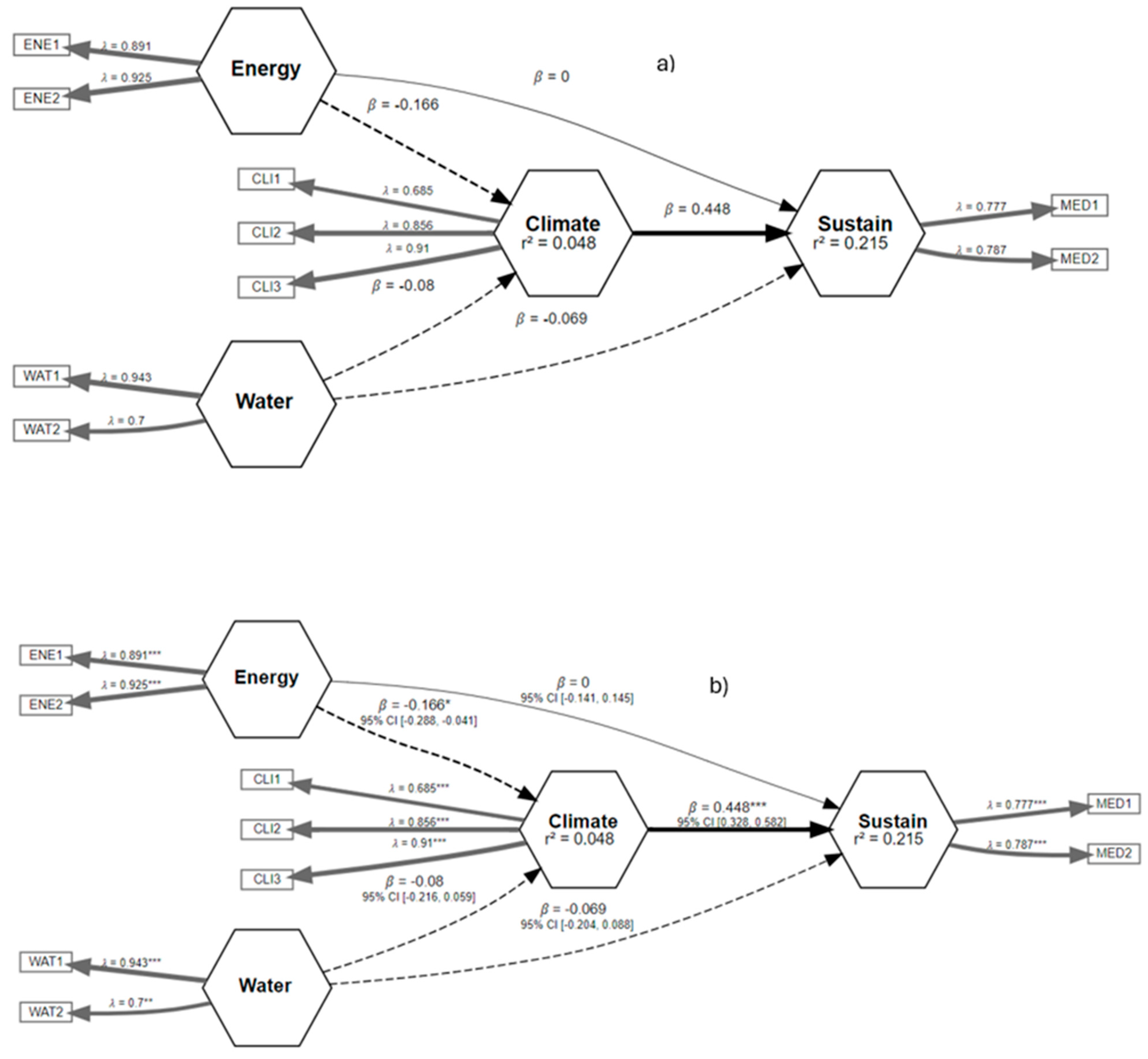

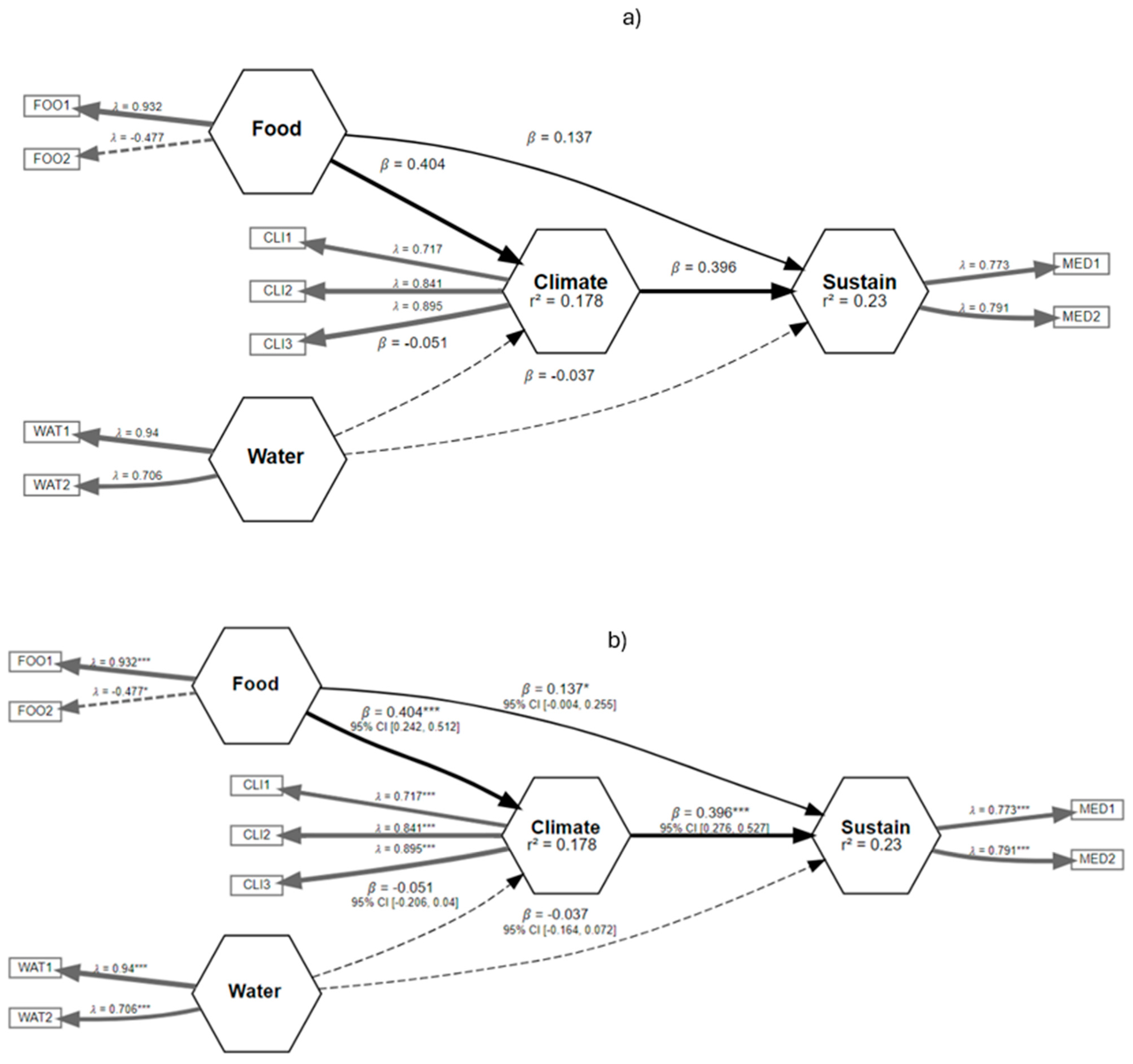

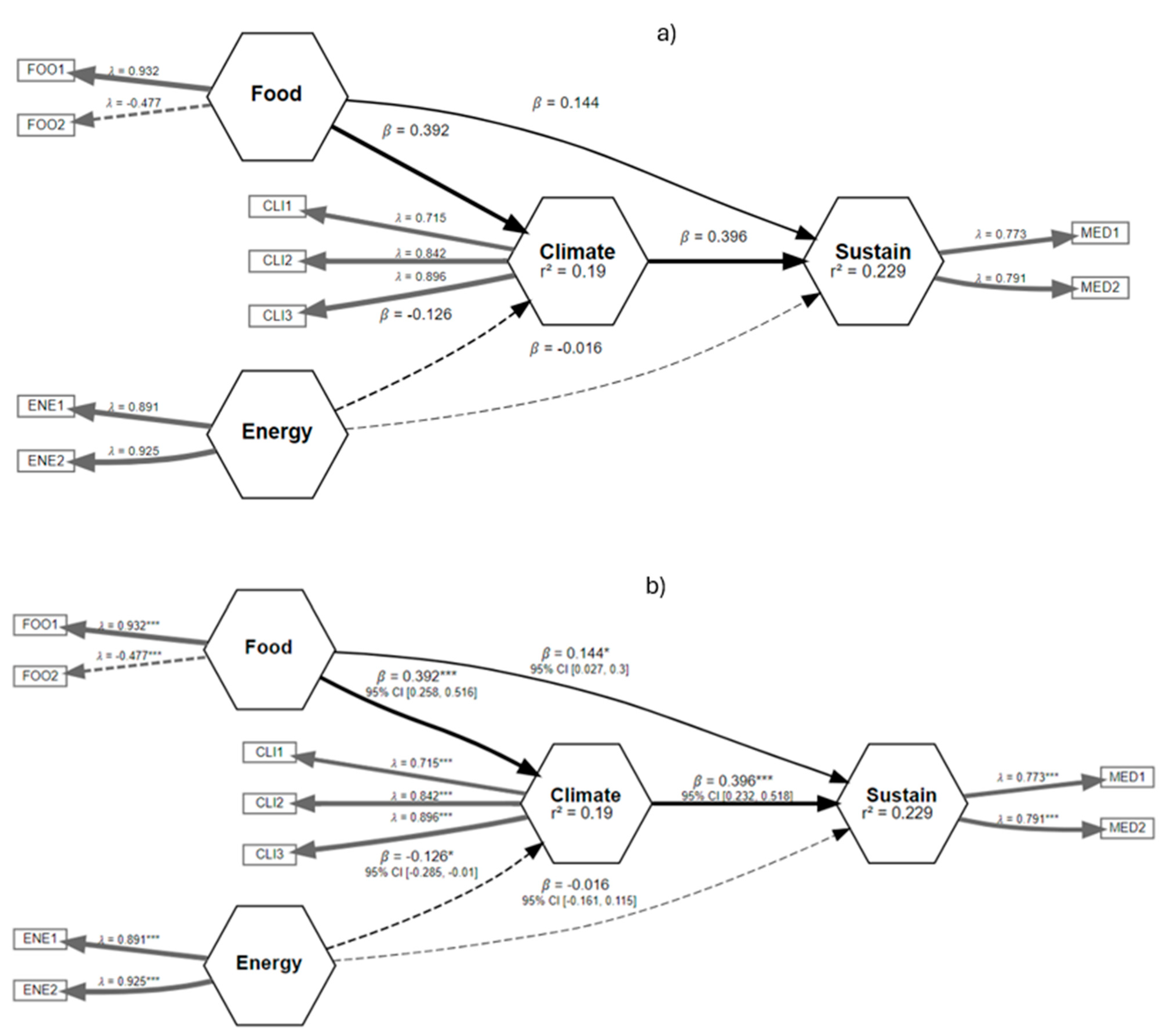
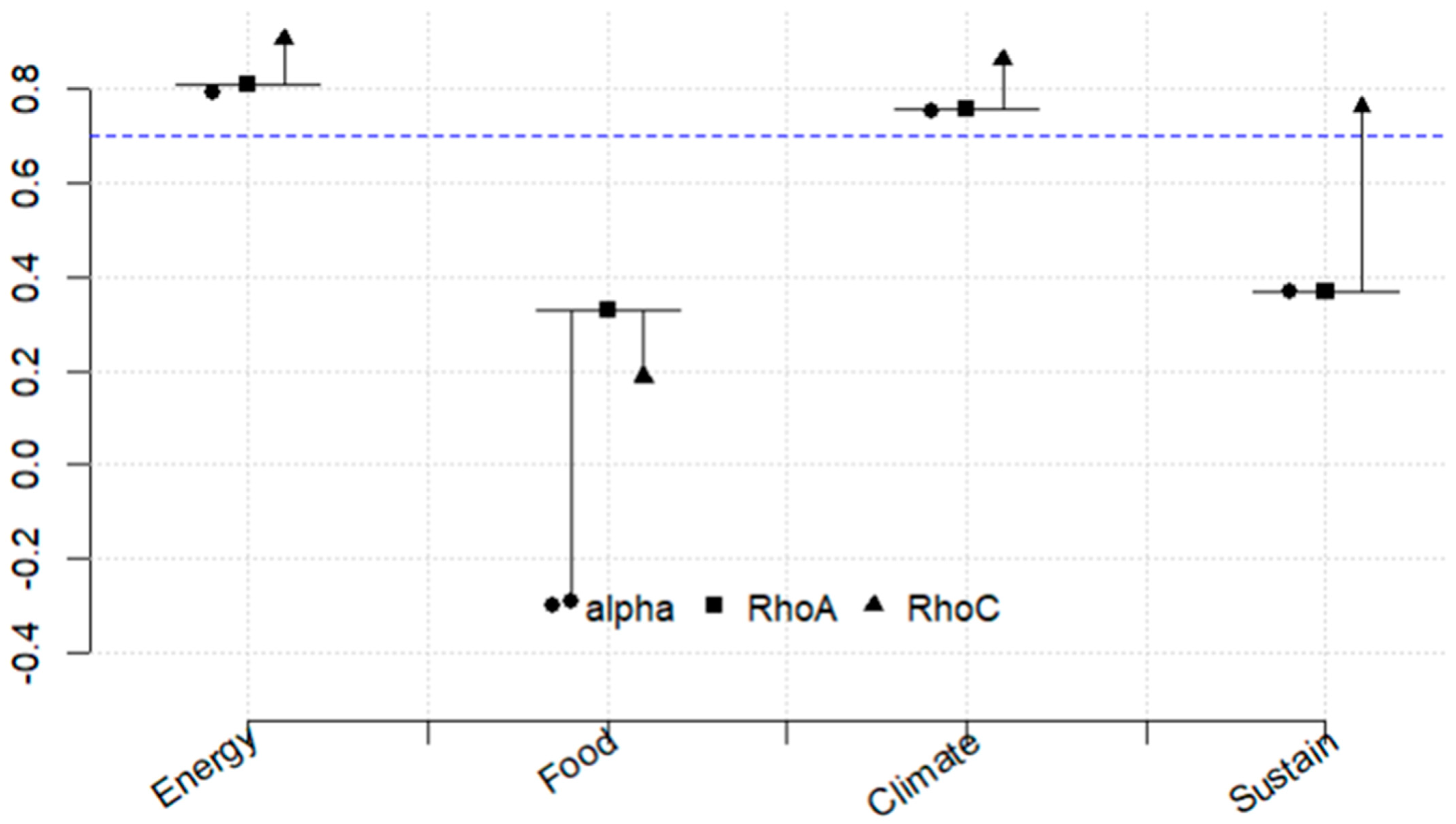
| Options | t-Test | Bartlett Test |
|---|---|---|
| Narok | p-value < 0.00 | p-value = 0.00 |
| Vhembe | p-value < 0.00 | p-value = 0.50 |
| Combined | p-value < 0.00 | p-value = 0.00 |
| Options | Contrasts | Independent Variable with Significance | p-Value | Adjusted r-Squared |
|---|---|---|---|---|
| Narok | Climate Change | Exposure Nutrition | 0.00 | 0.25 |
| Sustainable Development | 0.000 | 0.16 | ||
| Community Recovery | 0.020 | 0.06 | ||
| Vhembe | Climate Change | Exposure Nutrition | 0.13 | 0.46 |
| Sustainable Development | 0.68 | −0.14 | ||
| Community Recovery | 0.32 | 0.22 | ||
| Combined | Climate Change | Exposure Nutrition | 0.00 | 0.26 |
| Sustainable Development | 0.00 | 0.15 | ||
| Community Recovery | 0.01 | 0.08 |
| Predictors | Sust | Water | Energy | Climate | Food | |||||
|---|---|---|---|---|---|---|---|---|---|---|
| Estimates | CI | Estimates | CI | Estimates | CI | Estimates | CI | Estimates | CI | |
| (Intercept) | 0.90 | −0.30–2.10 | 1.30 * | 0.14–2.46 | 1.50 ** | 0.53–2.47 | 3.04 *** | 2.36–3.73 | 0.25 | −0.78–1.27 |
| WAT1 | 0.12 | −0.02–0.26 | −0.02 | −0.13–0.09 | 0.05 | −0.05–0.14 | 0.26 *** | 0.15–0.37 | ||
| WAT2 | −0.14 | −0.30–0.03 | 0.32 *** | 0.20–0.44 | 0.03 | −0.08–0.14 | −0.12 | −0.25–0.01 | ||
| WAT3 | 0.11 | −0.05–0.27 | 0.12 | −0.01–0.25 | −0.04 | −0.15–0.07 | 0.04 | −0.09–0.17 | ||
| ENE1 | 0.10 | −0.12–0.31 | −0.07 | −0.21–0.07 | 0.22 * | 0.05–0.39 | ||||
| ENE2 | −0.11 | −0.33–0.10 | 0.03 | −0.12–0.17 | −0.14 | −0.31–0.03 | ||||
| CLI1 | 0.20 | −0.01–0.42 | 0.08 | −0.12–0.28 | −0.06 | −0.23–0.11 | 0.30 *** | 0.12–0.47 | ||
| CLI2 | 0.15 | −0.12–0.42 | 0.11 | −0.14–0.36 | −0.09 | −0.29–0.12 | 0.13 | −0.08–0.35 | ||
| CLI3 | 0.21 | −0.05–0.48 | −0.07 | −0.31–0.18 | −0.02 | −0.22–0.18 | −0.00 | −0.21–0.21 | ||
| MED1 | 0.04 | −0.10–0.17 | 0.03 | −0.08–0.14 | 0.10 * | 0.02–0.19 | 0.06 | −0.05–0.16 | ||
| MED2 | 0.04 | −0.10–0.17 | −0.00 | −0.11–0.10 | −0.00 | −0.09–0.08 | −0.02 | −0.13–0.09 | ||
| MED3 | −0.05 | −0.20–0.11 | −0.07 | −0.19–0.06 | 0.11 * | 0.00–0.22 | 0.15 * | 0.01–0.28 | ||
| FOO1 | 0.38 *** | 0.23–0.54 | 0.14 * | 0.01–0.27 | 0.21 *** | 0.10–0.32 | ||||
| FOO2 | 0.00 | −0.16–0.16 | 0.15 * | 0.00–0.30 | −0.10 | −0.22–0.03 | ||||
| Observations | 197 | 188 | 208 | 212 | 212 | |||||
| R2/R2 adjusted | 0.178/0.143 | 0.166/0.129 | 0.303/0.264 | 0.223/0.184 | 0.315/0.278 | |||||
| Water, Energy, Climate, and Sustainability | Water, Food, Climate, and Sustainability | Energy, Food, Climate, and Sustainability | |||||||
|---|---|---|---|---|---|---|---|---|---|
| Mediation Paths | SD | CI (25%) | CI (97.5%) | SD | CI (25%) | CI (97.5%) | SD | CI (25%) | CI (97.5%) |
| Water–climate–sustainability | 0.04 | −0.11 | 0.02 | 0.02 | −0.07 | 0.02 | - | - | - |
| Energy–climate–sustainability | 0.03 | −0.14 | −0.01 | - | - | - | 0.03 | −0.12 | −0.00 |
| Food–climate–sustainability | - | - | - | 0.05 | 0.08 | 0.24 | 0.05 | 0.07 | 0.25 |
| Climate–sustainability | 0.07 | 0.32 | T0.59 | 0.06 | 0.28 | 0.53 | 0.07 | 0.23 | 0.52 |
Disclaimer/Publisher’s Note: The statements, opinions and data contained in all publications are solely those of the individual author(s) and contributor(s) and not of MDPI and/or the editor(s). MDPI and/or the editor(s) disclaim responsibility for any injury to people or property resulting from any ideas, methods, instructions or products referred to in the content. |
© 2024 by the authors. Licensee MDPI, Basel, Switzerland. This article is an open access article distributed under the terms and conditions of the Creative Commons Attribution (CC BY) license (https://creativecommons.org/licenses/by/4.0/).
Share and Cite
Zwane, N.; Botai, J.O.; Botai, C.M.; Mabhaudhi, T. Sustainability of the Linkages Between Water–Energy–Food Resources Based on Structural Equation Modeling Under Changing Climate: A Case Study of Narok County (Kenya) and Vhembe District Municipality (South Africa). Sustainability 2024, 16, 9689. https://doi.org/10.3390/su16229689
Zwane N, Botai JO, Botai CM, Mabhaudhi T. Sustainability of the Linkages Between Water–Energy–Food Resources Based on Structural Equation Modeling Under Changing Climate: A Case Study of Narok County (Kenya) and Vhembe District Municipality (South Africa). Sustainability. 2024; 16(22):9689. https://doi.org/10.3390/su16229689
Chicago/Turabian StyleZwane, Nosipho, Joel O. Botai, Christina M. Botai, and Tafadzwanashe Mabhaudhi. 2024. "Sustainability of the Linkages Between Water–Energy–Food Resources Based on Structural Equation Modeling Under Changing Climate: A Case Study of Narok County (Kenya) and Vhembe District Municipality (South Africa)" Sustainability 16, no. 22: 9689. https://doi.org/10.3390/su16229689
APA StyleZwane, N., Botai, J. O., Botai, C. M., & Mabhaudhi, T. (2024). Sustainability of the Linkages Between Water–Energy–Food Resources Based on Structural Equation Modeling Under Changing Climate: A Case Study of Narok County (Kenya) and Vhembe District Municipality (South Africa). Sustainability, 16(22), 9689. https://doi.org/10.3390/su16229689







